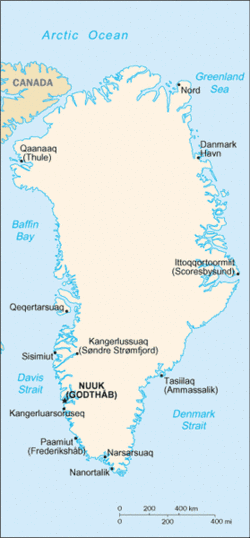Welcome to the Virtual Education Wiki ~ Open Education Wiki
Greenland
by Paul Bacsich
For entities in Greenland see Category:Greenland
Partners situated in Greenland
None.
Greenland in a nutshell
Greenland (Danish: Grønland; Kalaallisut: Kalaallit Nunaat, meaning "Land of the people") is an autonomous country within the Kingdom of Denmark. It is located between the Arctic Ocean and Atlantic Ocean, east of the Arctic Archipelago of Canada.
Though physiographically a part of the continent of North America, Greenland has been politically associated with Europe (specifically Denmark) since the 18th century.
In 1979, Denmark granted home rule to Greenland, with a relationship known in Danish as Rigsfællesskabet, and in 2008 Greenland voted to transfer more competencies to the local government. This became effective the following year, with the Danish royal government remaining in charge only of foreign affairs, security and financial policy, and providing a subsidy of DKK 3.4 billion ($633m), or approximately US$11,300 per Greenlander, annually.
Greenland is, by area, the world's largest island that is not a continent in its own right, as well as the least densely populated country in the world. However, since the 1950s, scientists have hypothesized that the ice cap covering the country may actually conceal three separate island land masses that have been bridged by glacier.
The population is around 60,000.
The capital and largest city is Nuuk (Godthåb).
Greenland education policy
AoILVET is the Agency of Industry, Labour Market and Vocational Education and Training.
- Parliament adopted the Greenland Education Programme (GEP) in 2005 in recognition of the low educational level in Greenland, which is viewed as an impediment to economic development and improvement of living conditions.
- GEP’s overall purpose is to ensure that two-thirds of the work force has an education providing them with academic qualifications or vocational skills in 2020.
- In its first phase (2006-2012) the GEP focuses on lower secondary school leavers who drop out of the educational system after graduation and on unskilled workers under 50 who are unemployed, in threatened trades and/or breadwinners for a family. In the second phase (2013-2020) the focus will be on higher education.
- Expenditure on GEP was 9.0 million Euros in 2006, 26.4 million Euros in 2007 and is expected to reach 38.1 million Euros in 2008.
- Implementation of the GEP is supervised by the Executive Steering Committee, which has members from several ministries and from the Association of the Municipalities in Greenland. The secretariat of the GEP is presently located within the Agency of Industry, Labour Market, and Vocational Education and Training (AoILVET). The AoILVET is also responsible for the bi-annual debriefings to Parliament on the progress of the GEP.
Source:http://uk.nanoq.gl/sitecore/content/websites/uk,-d-,nanoq/emner/international_relations/gep.aspx
Greenland education system
Education is free and compulsory for all children between the ages of 7 and 16. About 100 school centres have been established, and their languages of instruction are both Greenlandic (an Inuit language with some Danish words) and Danish. A university centre is at Nuuk.
Higher education
Universities in Greenland
The sole university, University of Greenland (Ilisimatusarfik), has (as of 2007) approximately 150 students, almost all local inhabitants, and around 14 academic staff and five technical-administrative employees. The modest student population is due in part to the government's policy allowing students a free university education anywhere in Europe or North America.
Its web site is http://www.ilisimatusarfik.gl
Polytechnics in Greenland
Higher education reform
The Bologna Process
Administration and finance
Quality assurance
Greenland's HEIs in the information society
Towards the information society
Information society strategy
Virtual Campuses in HE
Interesting Virtual Campus Initiatives
Interesting Programmes
Re.ViCa Case-study
None.
Lessons learnt
References
For OER policies and projects in Greenland see Greenland/OER
